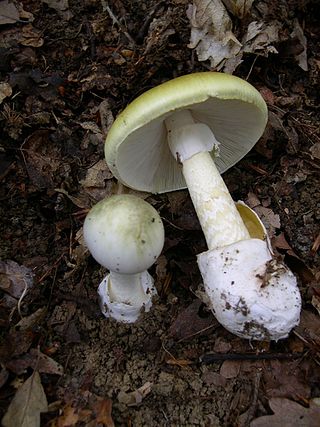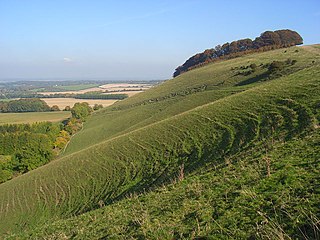Durango is a state in Mexico.

Echium plantagineum, commonly known as purple viper's-bugloss or Patterson's curse, is a species of the genus Echium native to western and southern Europe, northern Africa, and southwestern Asia. It has also been introduced to Australia, South Africa, and United States, where it is an invasive weed. Due to a high concentration of pyrrolizidine alkaloids, it is poisonous to grazing livestock, especially those with simple digestive systems, such as horses.

Daphne is a genus of between 70 and 95 species of deciduous and evergreen shrubs in the family Thymelaeaceae, native to Asia, Europe and north Africa. They are noted for their scented flowers and often brightly coloured berries. Two species are used to make paper. Many species are grown in gardens as ornamental plants; the smaller species are often used in rock gardens. All parts of daphnes are poisonous, especially the berries.

Mushroom poisoning is poisoning resulting from the ingestion of mushrooms that contain toxic substances. Symptoms can vary from slight gastrointestinal discomfort to death in about 10 days. Mushroom toxins are secondary metabolites produced by the fungus.

Frankia is a genus of nitrogen-fixing bacteria that live in symbiosis with actinorhizal plants, similar to the Rhizobium bacteria found in the root nodules of legumes in the family Fabaceae. Frankia also initiate the forming of root nodules.

Dactylis is a genus of Eurasian and North African plants in the bluegrass subfamily within the grass family. Dactylis is native to North Africa, they are found throughout the world, and are an invasive species. They are known in English as cock's-foot or cocksfoot grasses, also sometimes as orchard grasses.

Rhynchospora is a genus of about 400 species of sedges with a cosmopolitan distribution. The genus includes both annual and perennial species, mostly with erect 3-sided stems and 3-ranked leaves. The achenes bear a beak-like tubercule and are sometimes subtended by bristles. Many of the species are similar in vegetative appearance, and mature fruits are needed to make a positive identification.

Cicuta, commonly known as water hemlock, is a genus of four species of highly poisonous plants in the family Apiaceae. They are perennial herbaceous plants which grow up to 2.5 meters (8 ft) tall, having distinctive small green or white flowers arranged in an umbrella shape (umbel). Plants in this genus may also be referred to as cowbane or poison parsnip. Cicuta is native to temperate regions of the Northern Hemisphere, mainly North America and Europe, typically growing in wet meadows, along streambanks and other wet and marshy areas. These plants bear a close resemblance to other members in the family Apiaceae and may be confused with a number of edible or poisonous plants. The common name hemlock may also be confused with poison hemlock, or with the Hemlock tree.

Aesculus californica, commonly known as the California buckeye or California horse-chestnut, is a species of buckeye native to California and southwestern Oregon.

Campanula glomerata, known by the common names clustered bellflower or Dane's blood, is a species of flowering plant in the genus Campanula, belonging to the family Campanulaceae. It is the county flower of Rutland, England.

Dactylis glomerata is a species of flowering plant in the grass family Poaceae, commonly known as cock's-foot, orchard grass, or cat grass (due to its popularity for use with domestic cats). It is a cool-season perennial C3 bunchgrass native throughout most of Europe, temperate Asia, and northern Africa.

Ham Hill is a hill and area of chalk downland in Wiltshire, England, on the steep banks running alongside the road from the village of Ham to Buttermere, close to the Berkshire border. A biological Site of Special Scientific Interest, notified in 1971, covers 1.5 hectares of the site; this designation is due to the site's species-rich plant and insect communities, which include some rare species. Notable among these is the musk orchid, which has been confirmed at only one other site in Wiltshire.

The Datiscaceae are a family of dicotyledonous plants, containing two species of the genus Datisca. Two other genera, Octomeles and Tetrameles, are now classified in the family Tetramelaceae.

Lupinus formosus, the summer lupine or western lupine, is a species of flowering plant in the legume family, Fabaceae. It is native to California and Oregon in the United States.
Alvordia is a genus of flowering plants in the family Asteraceae. It includes 4 species of shrubs which occur in the states of Baja California and Sonora, Mexico. The genus is characterized by having a secondary clustering of heads into compound units, so that what appears to be a single head is actually a group of heads packed together. The genus is classified as a member of subtribe Helianthinae, the same subtribe that contains the common sunflower (Helianthus). Based on the reported chromosome counts, Alvordia includes both diploid and polyploid species, but the relationships among these have not yet been studied in detail. No chromosome count has yet been reported for the species A. congesta from Sonora, which was a later transfer to the genus.

Delphinium exaltatum, known by the common name tall larkspur, is a species of flowering plant in the genus Delphinium, part of the buttercup family. Other Delphinium species are also commonly known as tall larkspur, such as Delphinium barbeyi. D. exaltatum is native to the central and eastern United States, where it can be found in Kentucky, Maine, Ohio, Pennsylvania, Maryland, West Virginia, Virginia, North Carolina, Alabama, Tennessee, and Missouri.
Melanaspis glomerata, the sugarcane scale or black scale, is a species of armoured scale insect in the family Diaspididae. It is native to the Indian subcontinent where it is a serious pest of sugarcane.

Datisca cannabina, called false hemp, is a species of flowering plant in the genus Datisca, family Datiscaceae, native to the Aegean Islands, Crete, Cyprus, Anatolia, the Levant, the Transcaucasus, Iraq, Iran, Central Asia, Afghanistan, Pakistan, the western Himalayas and Nepal. It is one of the very few species known to have true androdioecy, meaning it has a mix of male and hermaphroditic individuals.

Myrciaria glomerata, commonly known as cabeludinha-vermelha or cabeluda-escarlate, is a species of plant in the family Myrtaceae. It is an evergreen shrub or small tree, endemic to the north and east of Brazil. Myrciaria glomerata has historically been used to incorrectly describe Myrciaria glazioviana.















